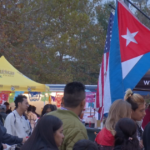TALLAHASSEE — Calling immigrants rapists and “blood-thirsty criminals,” talking of massive deportations on Day One and joking about Puerto Rico as a floating garbage island didn’t stop many Hispanics from voting to reelect former President Donald Trump.
On the contrary. This election saw Hispanic voters drifting toward Trump and his promise of a better economy and border security, both nationally and in Florida, exit polls and vote analyses conducted by national media outlets indicate.
Trump won the national popular vote 50.7% to 47.7% or by 4.4 million voters.
Vice President Kamala Harris still won the Hispanic vote — 53% to Trump’s 45%, according to an NBC exit poll. But that’s a huge drop from the 66% of the Hispanic vote President Biden received in 2020, which was on par with Hillary Clinton’s Hispanic support in 2016.
In Florida, Trump beat Harris by 13 points, 56 percent to 43 percent, in a state that has the third largest Latino-eligible voting population at 3.3 million with about 1 million identifying as Puerto Rican. That’s a big gain over 2020, when Trump led Biden 51% to 48%.
What emerged from post-election interviews with Hispanic voters in Central Florida this week was the motivating power of social and pocketbook issues, despite the slights many heard but ultimately dismissed in deciding how to vote.
“Trump is crazy, but he has values and what he says he does,” said Aridia Figueroa, 73, a native of the Dominican Republic who’s lived in Osceola County for 20 years and is a retired Disney housekeeper. “When he was president the gas was low…and most important to me, as a Christian, he united religion with the government.”
Their shift in allegiance helps explain why some Democratic strongholds in Florida have either flipped for Trump or shifted toward Republicans.
Analysts say Trump also succeeded in clawing back the White suburban voters who went with Biden in 2020, striking a chord with young and first-time voters that Harris failed to connect with, appealing to lower-income voters disaffected with Biden’s handling of the economy and driving greater turnout among Republican voters. The only group that stuck with the Democrats were Black voters, polls show.
Harris carried only six Florida counties – Alachua, Broward, Gadsden, Leon, Broward, Orange and Palm Beach.
But even heavily Democratic Orange County lurched to the right – Harris carried the county by 13.5 points, compared to the 23-point margin Biden held over Trump in 2020.
Also for the first time this year, Trump won Miami-Dade County, a former Democratic stronghold, capturing 55.2% of the votes to 43.7% by Harris.
The movement of Hispanic voters becomes clear in Osceola County, a longtime Democratic bellwether of mostly working class Puerto Rican Hispanics that polled heavily for Hillary Clinton with 60% of the vote in 2016 and gave Joe Biden a 13.8-point lead in 2020. This year, it tilted slightly toward Trump – by 1.4% or 2,500 votes.
That places it squarely in context with the 86 Hispanic-majority counties across the country, which shifted a total of 13.3 percentage points more Republican in the presidential election than they had voted in 2020, according to a New York Times analysis.
“There was an unambiguous massive swing with all Hispanic voters, including Puerto Ricans,” said Matt Isbell, a Democratic political consultant who specializes in mapping voter statistics and has focused on Osceola.
When he first noticed the shift to the right, Isbell said it was his “Oh no!” moment.
“This was a bigger moment than when Miami-Dade went red in 2022,” Isbell said, referring to the Red Wave that helped Gov. Ron DeSantis and other statewide officers post double-digit leads over their opponents.
That shift didn’t happen overnight, he said.
In Osceola County, the heaviest concentration of Hispanics, and Puerto Ricans in particular, is in the west end, he said. “In the last eight years it has gone from a deep deep deep blue to light red,” he said.
The comments from Trump’s Madison Square Garden rally about Latinos loving to make babies and Puerto Rico being a floating garbage island weren’t disqualifying for these Hispanic voters.
“The key thing for Democrats is that it really shows for all the Republican race-bashing . . . that didn’t prove to be the big thing,” Isbell said. “It reflects how much economic issues drove this.”
Karla Rosario, 35, a native Puerto Rican who lives in Buenaventura Lakes and voted for President Joe Biden in 2020, said she wasn’t fazed by the comedian Tony Hinchcliffe’s comments at Trump’s Madison Square Garden rally.
“If they come to Puerto Rico tell them to bring trash bags so they can help pick up the trash that’s all over the beaches,” Rosario said.
Rosario voted for Biden in 2020 but became disillusioned with his handling of the economy. The Republican Party “is more about pushing the nation towards progress … and is going to be better than Joe Biden,” she said.
Maria Revelles, 54, a native-born Puerto Rican who ran unsuccessfully for the state House District 47 seat against incumbent Republican Paula Stark, said many Democratic politicians could not connect with Hispanic voters because they didn’t understand what was important to them.
“For many Hispanic communities, there is a big disconnect between politics and real life,” said Revelles, an affordable housing advocate and labor union organizer. “A lot of times the message is translated by people that are not in touch with the realities we face in our lives.”
People remember, falsely or correctly, the economy being better for them under Trump, she said. Families received relief checks during the COVID-19 pandemic with Trump’s name on them even though the money was approved by Congress.
“Not every person can see and make the connection of the global inflation that we are still bouncing back from the pandemic,” Revelles said. “People want relief, their roof replaced.”
Kissimmee resident Juan Maldonado, 36, remembers things being better a decade ago when rent was still affordable. He said he voted for Trump because he “wanted everything back to normal.”
“I can see both sides…but at the end of the day Trump says he can bring the economy back,” said Maldonado, whose was born in Florida but whose family is from Puerto Rico.

Social issues were also important for many Hispanics, said James Book, the senior minister at Kissimmee Christian Church, which rallied its members to vote against Amendment 4, the abortion rights measure on the Florida ballot.
“I’ve been working very closely with the Puerto Rican community over the last 14 years,” he said. “Hispanics are very conservative when it comes to their faith and to life and to families.”
While the exit polls in Florida showed support for Trump, generally, it was a small sample of voters and it was unclear where they were polled, said Daniel Smith, chief of political science at the University of Florida and an expert on elections. But he has no doubt of the Hispanic shift in Osceola and similar regions.
A big factor in Osceola County were the voters who don’t identify with any party but make up the largest bloc of registered voters, Smith said. Roughly 47% of the 86,373 registered No Party Affiliation voters turned out — compared to about 76% of the 86,063 registered Democrats and the 65,806 Republicans — but those numbers are still sizable. And in this election, Smith believes, they boosted Trump.
Many of those NPA voters are young Hispanic males, Smith said. And national exit poll data shows more young Latino men voting for Trump and more Latina women voting for Harris.
“They are just showing pride and a repudiation of past experience, casting off their native country,” he said. “There is no question we are seeing a rightward shift, even among Puerto Ricans.”











